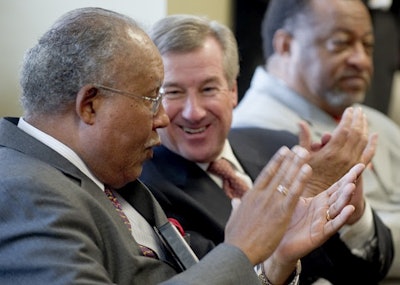 President William H. Harris (left) and Montgomery mayor Todd Strange (r) applaud during a 2011 press conference held by the National Park Service announcing ASU as the official Montgomery site for the Selma to Montgomery March Interpretative Center. Photo by David Campbell/ASU
President William H. Harris (left) and Montgomery mayor Todd Strange (r) applaud during a 2011 press conference held by the National Park Service announcing ASU as the official Montgomery site for the Selma to Montgomery March Interpretative Center. Photo by David Campbell/ASUAlabama State University has moved one step closer to start construction on the third and final Selma to Montgomery Voting Rights Interpretive Center after the state of Alabama announced it is awarding the HBCU with an $800,000 grant, school officials said Tuesday.
Last week, Dr. Janice Franklin, director of the school’s National Center for the Study of Civil Rights and African-American Culture, announced at a public hearing that the $800,000 grant will go toward a National Park Service-managed museum showcasing the history of the 1965 Voting Rights campaign. ASU officials are seeking a total of $3 million to have the Voting Rights Interpretive Center completed by March 2015, which will be the 50th anniversary month of the historic Selma to Montgomery March.
Securing the grant “means that we’re much closer to making this thing happen,” said Dr. Howard Robinson, the ASU archivist. “We are very committed and excited about having this interpretive center open for the 50th anniversary of the Selma to Montgomery march.”
“The Voting Rights Act changed the political dynamics of this nation. We think it’s important to celebrate that,” added Robinson.
Currently, along the federally-designated Selma to Montgomery National Historic Trail in Alabama, the National Park Service operates Voting Rights Interpretive Centers in Selma and Lowndes County. In 2011, the National Park Service chose the ASU campus to be the site for the third center, according to ASU.
Alabama state Rep. Thad McClammy (D-Montgomery) told Diverse Tuesday that ASU is slated to receive a $1.2 million grant from the state’s Department of Conservation, pending final approval by a department oversight committee. He said he expects the grant, which will support construction of the Voting Rights Interpretive Center, to be approved by the end of the summer.
“At this point, it’s just a formality with the committee members to okay the funding,” said McClammy, an ASU graduate who was a student at the university in 1965.
Additional center construction funds are being sought through the Alabama Department of Transportation. Last week, ASU’s National Center convened a public hearing that highlighted a $500,000 grant application request to the transportation department to fund infrastructure improvements needed for the Voting Rights Interpretive Center.
Robinson said that, with the third Voting Rights Interpretive Center slated to be on the school’s campus, its presence will help produce a better public understanding of the role ASU and ASU students played in March 1965 when many of the most dramatic events of the Voting Rights campaign took place. He noted that members of the famed Student Nonviolent Coordinating Committee civil rights organization chose Montgomery as their base of operations during much of March 1965.
Robinson noted that, while the Voting Rights Interpretive Center will be critical to the university, the facility will be one of several within a historical and cultural district ASU is establishing, which will cost between $15 million and $20 million to fully develop.
In addition to the Voting Rights Interpretive Center, a second museum is planned for the campus, according to Robinson. The facility will showcase civil rights history, such as the Montgomery Bus Boycott, the Freedom Rides, the lunch counter sit-ins and the First Amendment case of New York Times Co. v. Sullivan.
“This campus is a living museum … [In 1965,] you had over 1,000 students leave campus en masse and join the Selma to Montgomery March,” Robinson said. “[ASU] students participated in the sit-ins; the announcement fliers of the Montgomery Bus Boycott were created on campus by professors; and so all of these episodes really are the history of the university.”















